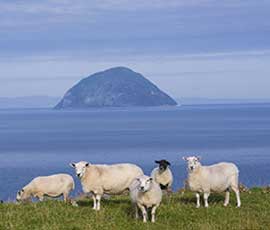‘Green shoots’ appear in Scots livestock industry

Careful investment is the key to improving margins in livestock businesses, according to Quality Meat Scotland (QMS).
Rather than “investing for the sake of it”, farmers should be investing to make their systems function better.
For example, mechanised feeding adds depreciation costs but lowers staffing costs and improves feed efficiency by reducing waste.
“It might take two or three years to pay back investment, but the efficiency might last for 10 years,” said Stuart Ashworth, head of economic services, speaking on the launch of QMS’s Cattle and Sheep Enterprise Profitability in Scotland report.
The report, which provides a snapshot of the industry during the 2012 calf and lamb crop year, compares the costs, revenues and margins achieved by the top third of producers, the bottom third and the sample average for each sector.
Challenging weather had tested livestock farmers, the report said, with only intensive cereal-based cattle finishers improving margins during this time.
The report stated:
• Only 22% of the suckler herds surveyed reported a positive net margin from which to pay family labour and reward the risk capital invested in the business, down from 30% last year
• Margins were maintained more easily among store cattle finishers, where 59% of businesses surveyed achieved a positive net margin, little changed from the 60% which achieved this objective last year
• Falling margins among ewe flocks resulted in 19% of hill flocks returning a positive margin, down from 57% last year
• A total of 47% of upland flocks recorded a positive net margin, down from 100% last year
• Among lowground flocks 83% of those surveyed recorded a positive margin, down from 100% last year
• Half of the store lamb finishers achieved a positive net margin compared with 92% achieving this objective last year
“Nevertheless, even those businesses reporting positive net margins still struggled to deliver a fair return for labour and capital,” said the report.
Top-performing farms generally had high physical or technical performance, strong control over costs and maximised returns from the marketplace, it added.
“These farmers tend to demonstrate striving for excellence,” said Mr Ashworth,
2012 produced lower margins, which came as “no surprise” to him, after the poor weather from the autumn right through to spring 2013 created “legacy issues”, with a 5% smaller Scottish lamb crop in 2013 and calf registrations struggling to match 2012 levels, he said.
A better winter and improved prices would help this situation, he said.
Prices across all livestock enterprises were generally better than last year, said Mr Ashworth. And, while costs were also higher than previous years, there was still a chance for farmers to improve on last year’s margins this year.
“There are the beginnings of some green shoots emerging,” he said. “Even in the bad winter, every business had some strengths and success stories. We need to look at other people’s success stories and think how we can apply them to our business,” he advised.
